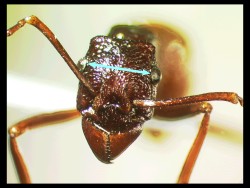
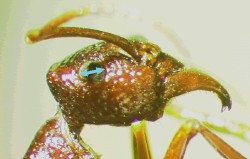
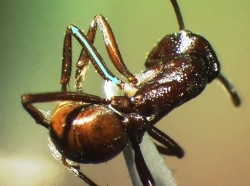
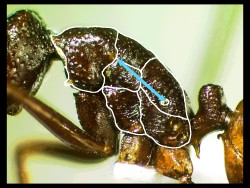
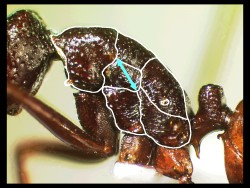
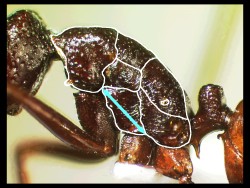
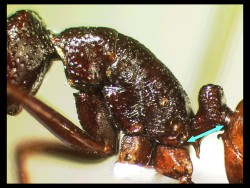

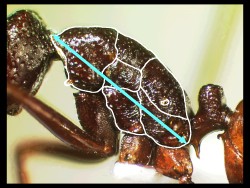
Appendix B. Morphometric character description and images and accompanying notes on their possible ecological relevance.
| No. |
Character |
Description |
Image |
| 1 |
Distance
between eyes |
The
shortest distance from the inner edge of one eye to the inner edge of the
other eye. |
 |
| 2 |
Length
of eye |
The
longest antero-posterior axis of the eye. |
 |
| 3 |
Length
of mid-femur |
Length
of the femur of the middle leg. |
 |
| 4 |
Landmark
1 to landmark 2 |
The
distance between Landmark 1 and Landmark 2 of Crozier et
al. (1986). Landmark 1 is the suture intersection between the pronotum,
the upper mesonotum, and the central mesonotum. Landmark 2 is the propodeal
spiracle. |
 |
| 5 |
Landmark
1 to landmark 5 |
The
distance between Landmark 1 and Landmark 5 of Crozier et
al. (1986). Landmark 1 is the suture intersection between the pronotum,
the upper mesonotum, and the central mesonotum. Landmark 5 is the suture
intersection between the propodeum, central mesonotum and lower mesonotum. |
 |
| 6 |
Landmark
3 to landmark 4 |
The
distance between Landmark 3 and Landmark 4 of Crozier et
al. (1986). Landmark 3 is the suture intersection of the pronotum, the
central mesonotum, and the lower mesonotum. Landmark 4 is the lowermost
point of suture intersection between the lower mesonotum and the propodeum. |
 |
| 7 |
Length
of petiole |
Longest
antero-posterior axis of petiole node. |
 |
| 8 |
Length
of scape |
Length
of the antennal scape. |
 |
| 9 |
Weber's
length |
Distance
from the anterodorsal margin of the pronotum to the posteroventral margin
of the propodeum (Brown 1953). |
 |
A Note on the selection of morphometric
characters used in this study:
We accept that, while
there is a relationship between morphology and ecology, it is not necessarily
true that all characters will be equally involved in competitive interactions.
It also follows that overdispersion in a character may not be attributable solely
to interspecific competition. We find it difficult, however, to establish apriori,
firstly, the ecological significance of a character, and, secondly, its involvement
in competitive interactions. This is particularly true for species (or OTUs)
whose natural history is largely unknown. We have therefore, taken an agnostic
attitude as to the ecological significance of the characters, or combinations
thereof, and simply ask whether the character set, as a multidimensional whole,
exhibits overdispersion (relative to a null model) in our test assemblages.
While our agnosticism allows us to work with these relatively poorly known organisms,
it greatly complicates interpretation of the observed patterns of overdispersion
as being the result, principally or exclusively, of interspecific competition
over ecological and evolutionary time scales.
Despite our reservations, we have some confidence in the character set as a
reflector of the varying ecological strategies of the OTUs. In a Principal Components
Analysis of all the measured specimens, all the characters were positively correlated
with the first principal component, which itself comprised 90.86% of the total
variance (see Appendix C). This indicates to us
that the character set as a whole largely reflects variation in body size -
a trait widely recognised as ecologically significant. Additionally, we envisage
several characters (1, 2, and 8) playing a role in the foraging strategies of
the OTUs, while the length of the middle femur probably plays a role in foraging
range.
LITERATURE
CITED
Brown, W. L. Jr. 1953. Revisionary studies in the ant tribe Dacetini. American Midland Naturalist 50:1–137.
Crozier, R. H., P. Pamilo, R. W. Taylor, and Y. C. Crozier. 1986. Evolutionary patterns in some putative Australian species in the ant genus Rhytidoponera. Australian Journal of Zoology 34:535–560